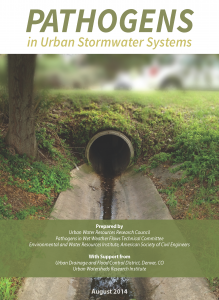 On Oct. 1, the American Society of Civil Engineers Environmental and Water Resources Institute released a new report entitled “Pathogens in Urban Stormwater Systems.” According to the U.S. Environmental Protection Agency, elevated fecal indicator bacteria are the most common cause of water quality impairment in the U.S. Fecal indicator bacteria are used as a surrogate for pathogens resulting from human and animal waste and can come from leaking sanitary infrastructure, illicit connections, sewer overflows, wildlife, and more.
On Oct. 1, the American Society of Civil Engineers Environmental and Water Resources Institute released a new report entitled “Pathogens in Urban Stormwater Systems.” According to the U.S. Environmental Protection Agency, elevated fecal indicator bacteria are the most common cause of water quality impairment in the U.S. Fecal indicator bacteria are used as a surrogate for pathogens resulting from human and animal waste and can come from leaking sanitary infrastructure, illicit connections, sewer overflows, wildlife, and more.
Bacteria and other pathogens pose a human health risk, particularly in recreational waters. However, beach closures and complying with total maximum daily loads (TMDLs) can be costly for communities. Some municipal separate storm sewer system (MS4) permit holders face significant pathogen wasteload reduction requirements through TMDLs.
However, identifying pathogen sources can be challenging, and there is significant uncertainty in monitoring pathogen transport and fate, which carries over into management strategies and regulatory decisions. The report recommends additional policy discussions for achieving an approach that protects public health but also recognizes cost constraints, technology limitations, and controllability of fecal indicator bacteria sources. For instance, fecal indicator bacteria concentrations in separate storm sewer discharges during wet weather are often orders of magnitude above primary contact recreation standards, regardless of land use, the report states.
The report is intended to help MS4 permit holders and watershed stakeholders develop effective and realistic goals and strategies for addressing pathogens. The report includes regulatory context for stormwater and pathogens, as well as chapters on pathogen sources, transport and fate, monitoring and source tracking, statistical analyses, source controls, structural controls, and bacteria TMDLs.
For instance, in terms of structural controls, the report recommends considering both concentration and volume reduction benefits and selecting practices with unit treatment processes that are effective at reducing pathogens. The report also discusses disinfection options, saying that chlorination and ozonation typically are impractical for stormwater applications, and while ultraviolet radiation is used, long-term operation and maintenance costs can be significant. “Generally, disinfection is considered an option when source controls and stormwater controls have not resulted in attainment of fecal indicator bacteria standards and elevated human health risks are present.” Read more.




